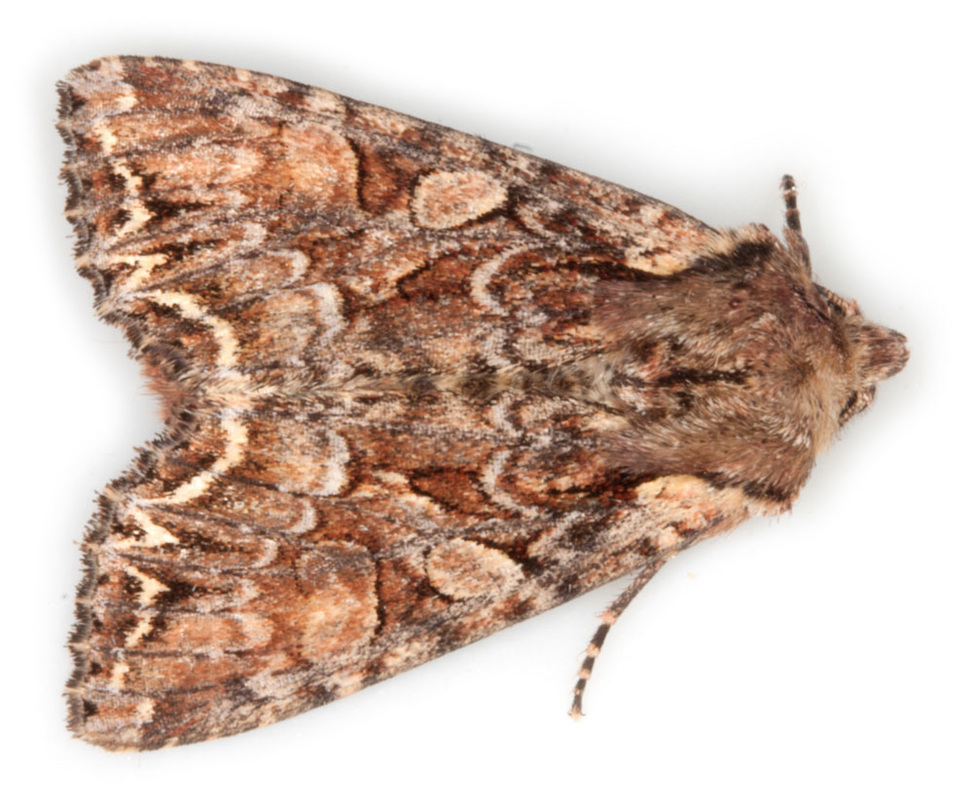Lacanobia |
|
The Lacanobia species are similar/overlapping in size (fw lengths in parenthesis below), mostly fly May-Jul and there are no distinctive geographical or habitat features that are likely to be helpful in separating them.
All British resident Lacanobia species have a pale subterminal line with a 'W' in the dorsal half. Usually in L.sausa (Dog's Tooth) (15-20mm) the two 'V's of the W are each filled with a white streak that extends proximal to the subterminal line. L.suasa is also unique (amongst the British Lacanobias) in having a solid dark dart mark. The brown form dissimilis of L.suasa, however, has a dark outlined rather than solid dark dart mark and has a standard 'W' mark without white streaks. This form is very similar to L.thalassina, but its antemedian and postmedian lines are almost obsolete. While other Lacanobias show a significant degree of ground colour variegation, L.oleracea (Bright-line-Brown-eye) (14-19mm) has a more uniformly brown ground colour in which the white subterminal line stands out. The stigmata are white outlined and the small kidney mark is filled with a paler brown than the ground colour (the 'brown eye'). Form dissimilis of L.suasa also has a fairly uniformly brown forewing ground colour in which the pale subterminal line stands out, but the dart mark is missing in L.oleracea and the oval is not white-outlined in form dissimilis. All Lacanobias except L.oleracea show a black median streak at the forewing base; and all Lacanobias except L.oleracea and form dissimilis of L.suasa have a pale patch (pale shoulder) between the costa and this black basal streak. The remaining species all have fairly large and generally pale oval and kidney marks and fairly well-marked pale antemedian and postmedian lines. L.w-latinum (Light Brocade) (18-21mm) has a pale subterminal fascia made more prominent by contrast with a brown median fascia which is delimited by a black paradorsal bar, dorsal to which the pale grey ground colour reaches the dorsum. L.contingua (Beautiful Brocade) (16-19mm) is quite variable in colour and strength of markings but it consistently shows an oblique pale mark between the pale oval mark and the postmedian line, this mark often 'continues' more diffusely towards the tornus between the postmedian and subterminal lines. (Usually the kidney mark is coloured (most often brown) and the white of the dorsal end of the postmedian line is prominent?) L.thalassina (Pale-shouldered Brocade) (16-20mm) is the least distinctive of the group. It has a more uniform usually reddish-brown ground colour than L.w-latinum or L.contigua and lacks the pale subterminal fascia of the former and the oblique pale mark of the latter. According to Waring & Townsend, it has a broader forewing and a more curved costa than other Lacanobias. but this does not seem sufficiently distinct to be useful in identification. It usually has a black median paradorsal bar with a small spur extending from the postmedian line towards the oval mark. And it usually shows fairly long black interneural arrowheads extending proximally from the dorsal half of the subterminal line. Apamea remissa (Dusky Brocade) also has a pale subterminal line with a 'W' mark, a black basal streak, often has a black median paradorsal bar and may have a suggestion of a pale subterminal fascia and so could be confused with some Lacanobia species, particularly L.w-latinum - but it does not have a 'pale shoulder' and the area dorsal to the paradorsal bar, when present, is the same colour as the rest of the median fascia. All Lacanobias have hairy eyes whilst in A.remissa the eyes are glabrous. This commentary above ignores L.splendens (Splendid Brocade) and L.blenna (Stranger). The former was new to Britain 2003 and doesn't look much like other Lacanobias, lacking the characteristic 'W' mark. The latter has not been reported in Britain since the 19th century, but does look similar to other Lacanobia species - the image of L.blenna at UKMoths looks very similar to L.contigua except that it lacks a white dorsal end to the postmedian line. It may be that the whitish hindwing of L.blenna is distinctive. |







